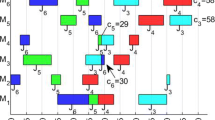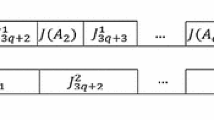Abstract
The m-machine no-wait flowshop scheduling problem, with the objective of minimizing total completion time subject to the constraint that makespan has to be less than or equal to a certain value, is addressed in this paper. First, an algorithm is proposed to find an upper bound on the makespan in case the upper bound is not given or unknown. Given the upper bound on makespan, a proposed algorithm (PAL) with five versions L (1, 5, 10, 15, and 20) and a genetic algorithm (GA) are utilized for solving the problem. Furthermore, a dominance relation is established for the case of four machines. The five versions of PAL and GA are evaluated on randomly generated problems with different number of jobs and number of machines. Computational experiments show that the errors of PA1 0, PA15, and PA20 are much smaller than that of GA while the CPU times of PA10, PA15, and PA20 are significantly smaller than that of GA. Therefore, the algorithms PA10, PA15, and PA20 are superior to the GA algorithm.
Similar content being viewed by others
References
Aldowaisan T, Allahverdi A (2003) New heuristics for no-wait flowshops to minimize makespan. Comput Oper Res 30:1219–1231
Aldowaisan T, Allahverdi A (2004) A new heuristic for m-machine no-wait flowshop to minimize total completion time. OMEGA Int J Manag Sci 32:345–352
Allahverdi A, Aldowaisan T (2002) No-wait flowshops with bicriteria of makespan and total completion time. J Oper Res Soc 53:1004–1015
Allahverdi A, Al-Anzi FS (2008) The two-stage assembly flowshop scheduling problem with bicriteria of makespan and mean completion time. Int J Adv Manuf Technol 37:166–177
Allahverdi A, Gupta JND, Aldowaisan T (1999) A review of scheduling research involving setup considerations. OMEGA Int J Manag Sci 27:219–239
Allahverdi A, Ng CT, Cheng TCE, Kovalyov MY (2008) A survey of scheduling problems with setup times or costs. Eur J Oper Res 187:985–1032
Aydilek H, Allahverdi A (2012) Heuristics for no-wait flowshops with makespan subject to mean completion time. Appl Math Comput 219:351–359
Bonney MC, Gundry SW (1976) Solutions to the constrained flowshop sequencing problem. Oper Res Q 24:869–883
Chen-Ritzo CH, Bagchi S, Burns LE, Catlett SC (2011) Experiences in implementing simulation-based support for operational decision making in semiconductor manufacturing. Eur J Ind Eng 5:272–291
Chen CL, Neppalli RV, Aljaber N (1996) Genetic algorithms applied to the continuous flow shop problem. Comput Ind Eng 30:919–929
Chien CF, Dauzere-Peres S, Ehm H, Fowler JW, Jiang Z, Krishnaswamy S, Lee TE, Monch L, Uzsoy R (2011) Modelling and analysis of semiconductor manufacturing in a shrinking world: challenges and successes. Eur J Ind Eng 5:254–271
El Amraoui A, Manier MA, El Moudni A, Benrejeb M (2012) Resolution of the two-part cyclic hoist scheduling problem with bounded processing times in complex lines' configuration. Eur J Ind Eng 6:454–473
Fink A, Voß S (2003) Solving the continuous flow-shop scheduling problem by metaheuristics. Eur J Oper Res 151:400–414
Framinan JM, Leisten R (2006) A heuristic for scheduling a permutation flowshop with makespan objective subject to maximum tardiness. Int J Prod Econ 99:28–40
Framinan JM, Nagano MS (2008) Evaluating the performance for makespan minimization in no-wait flowshop sequencing. J Mater Process Technol 197:1–9
Framinan JM, Nagano MS, Moccellin JV (2010) An efficient heuristic for total flowtime minimization in no-wait flowshops. Int J Adv Manuf Technol 46:1049–1057
Gangadharan R, Rajendran C (1993) Heuristic algorithms for scheduling in the no-wait flowshop. Int J Prod Econ 32:285–290
Goldberg DE (1989) Genetic algorithms in search, optimization, and machine learning. Addison-Wesley, Reading
Grabowski J, Pempera J (2005) Some local search algorithms for no-wait flow-shop problem with makespan criterion. Comput Oper Res 32:2197–2212
Hall NG, Posner ME (2001) Generating experimental data for computational testing with machine scheduling applications. Oper Res 49:854–865
Hall NG, Sriskandarajah C (1996) A survey of machine scheduling problems with blocking and no-wait in process. Oper Res 44:510–525
King JR, Spachis AS (1980) Heuristics for flowshop scheduling. Int J Prod Res 18:343–357
Klemmt A, Weigert G, Werner S (2011) Optimisation approaches for batch scheduling in semiconductor manufacturing. Eur J Ind Eng 5:338–359
Laha D, Chakraborty UK (2008) An efficient heuristic approach to total flowtime minimization in permutation flowshop scheduling. Int J Adv Manuf Technol 38:1018–1025
Laha D, Chakraborty UK (2009) An efficient hybrid heuristic for makespan minimization in permutation flow shop scheduling. Int J Adv Manuf Technol 44:559–569
Laha D, Chakraborty UK (2009) A constructive heuristic for minimizing makespan in no-wait flow shop scheduling. Int J Adv Manuf Technol 41:97–109
Lin SW, Ying KC (2012) Scheduling a bi-criteria flowshop manufacturing cell with sequence-dependent family setup times. Eur J Ind Eng 6:474–496
Madhushini N, Rajendran C (2011) Branch-and-bound algorithms for scheduling in an m-machine permutation flowshop with a single objective and with multiple objectives. Eur J Ind Eng 5:361–387
Michalewicz Z (1996) Genetic algorithms + data structures = evolution programs. Springer, Berlin
Naderi B, Salmasi N (2012) Permutation flowshops in group scheduling with sequence-dependent setup times. Eur J Ind Eng 6:177–198
Nagano MS, da Silva AA, Lorena LAN (2012) A new evolutionary clustering search for a no-wait flow shop problem with set-up times. Eng Appl Artif Intel 25:1114–1120
Pan WK, Tasgetiren MF, Liang YC (2008) A discrete particle swarm optimization algorithm for the no-wait flowshop scheduling problem. Comput Oper Res 35:2807–2837
Poppenborg J, Knust S, Hertzberg J (2012) Online scheduling of flexible job-shops with blocking and transportation. Eur J Ind Eng 6:497–518
Qian B, Wang L, Hu R, Huang DX, Wang X (2009) A DE-based approach to no-wait flow-shop scheduling. Comput Ind Eng 57:787–805
Rajendran C (1994) A no-wait flowshop scheduling heuristic to minimize makespan. J Oper Sci 45:472–478
Rajendran C, Chaudhuri D (1990) Heuristic algorithms for continuous flow-shop problem. Nav Res Logist 37:695–705
Samarghandi H, ElMekkawy TY (2011) An efficient hybrid algorithm for the two-machine no-wait flow shop problem with separable setup times and single server. Eur J Ind Eng 5:111–131
Schuster CJ, Framinan JM (2003) Approximative procedures for no-wait job shop scheduling. Oper Res Lett 31:308–318
Shyu SJ, Lin BMT, Yin PY (2004) Application of ant colony optimization for no-wait flowshop scheduling problem to minimize the total completion time. Comput Ind Eng 47:181–193
Soroush HM (2012) Solving the single machine scheduling problem with general job-dependent past-sequence-dependent setup times and learning effects. Eur J Ind Eng 6:596–628
Srirangacharyulu B, Srinivasan G (2011) Minimising mean squared deviation of job completion times about a common due date in multimachine systems. Eur J Ind Eng 5:424–447
Stubbe K, Rose O (2011) Simulation analysis of semiconductor manufacturing with small lot size and batch tool replacements. Eur J Ind Eng 5:292–312
Tajbakhsh A, Eshghi K, Shamsi A (2012) A hybrid PSO-SA algorithm for the travelling tournament problem. Eur J Ind Eng 6:2–25
Tseng LY, Lin YT (2010) A hybrid genetic algorithm for no-wait flowshop scheduling problem. Int J Prod Econ 128:144–152
Vinod V, Sridharan R (2009) Simulation-based metamodels for scheduling a dynamic job shop with sequence-dependent setup times. Int J Prod Res 47:1425–1447
Ying KC (2012) Minimising makespan for multistage hybrid flowshop scheduling problems with multiprocessor tasks by a hybrid immune algorithm. Eur J Ind Eng 6:199–215
Zhu J, Li X, Wang Q (2009) Complete local search with limited memory algorithm for no-wait job shops to minimize makespan. Eur J Oper Res 198:378–386
Author information
Authors and Affiliations
Corresponding author
Additional information
This research was conducted while the author Ali Allahverdi was a visiting professor at the Department of Industrial and Systems Engineering, Rensselaer Polytechnic Institute, Troy, New York. He was on sabbatical leave from Kuwait University.
Appendix (Proof of the Theorem)
Appendix (Proof of the Theorem)
Let
t k,m : processing time of job k on machine m(m = 1, 2, 3, and 4)
t [k,m]: processing time of the job in position k on machine m
C [k]: completion time of the job in position k on the fourth machine
We assume that every job requires processing on all machines, i.e., t j,k > 0. Such a four-machine no-wait flowshop is necessarily a permutation flow shop. In other words, the order of jobs on all machines must be the same.
It can be shown that for a job in position k,
where, \( {t_{{\left[ {0,2} \right]}}}={t_{{\left[ {0,3} \right]}}}={t_{{\left[ {0,4} \right]}}}=0 \).
Since the total completion time, TCT, is
It follows from Eq. 1 that
Consider two sequences σ 1 and σ 2 such that σ 1 has job i in an arbitrary position τ and job j in position τ + 1. The sequence σ 2 is exactly the same as σ 1 except that job j is in position τ and job i in position τ + 1.
Since the two sequences have the same job in positions up to and including τ − 1,
Then, we have the following equations for the two sequences,
It can be easily shown that if the conditions given in the hypothesis are satisfied, then Eq. 8 reduces to
Now, for C [k] where k = τ + 2, … , n,
Where \( \sum\limits_{{r=\tau +3}}^{{\tau +2}} {(.)=0} \).
It follows from Eqs. 10 and 11 that
Given that the conditions specified in the theorem are satisfied, then Eq. 12 satisfies
Hence, the inequality TCT(σ 1) ≤ TCT(σ 2) holds as a result of Eqs. 3, 9, and 13.
Rights and permissions
About this article
Cite this article
Allahverdi, A., Aydilek, H. Algorithms for no-wait flowshops with total completion time subject to makespan. Int J Adv Manuf Technol 68, 2237–2251 (2013). https://doi.org/10.1007/s00170-013-4836-x
Received:
Accepted:
Published:
Issue Date:
DOI: https://doi.org/10.1007/s00170-013-4836-x




